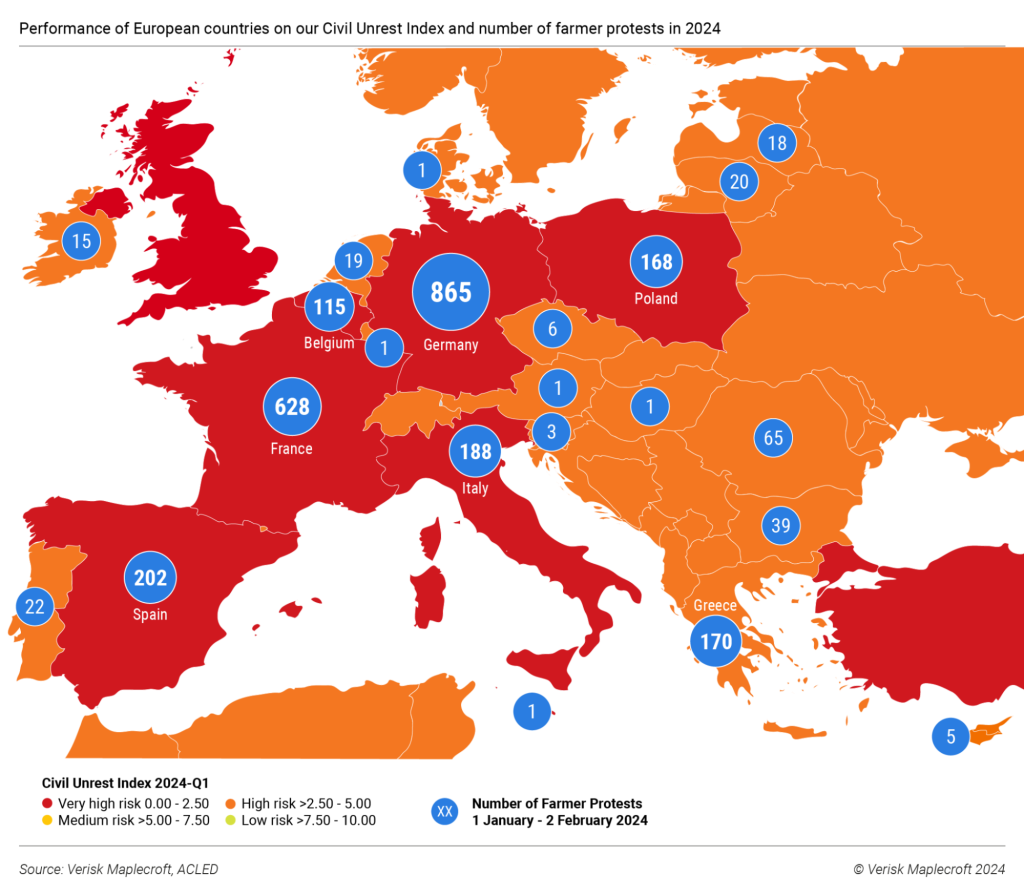Τοπικό: Σχέδιο Εμπορίου
Στόχοι Μαθήματος:
- Understand the Importance of Risk Tolerance: Learn how MiFID II and risk profiling methods assess an investor’s capacity to handle risk and ensure that investments match the investor’s goals, experience, and financial situation.
- Explore MiFID II Regulations: Understand the suitability και appropriateness assessments required by MiFID II, which help ensure that financial products match the investor’s risk preferences, especially for conservative investors.
- Identify Preferences of Conservative Investors: Learn about the capital preservation, stable income, και low volatility preferences common among conservative European investors, particularly in countries like Germany and Switzerland.
- Learn About Investment Vehicles for Conservative Investors: Discover the types of investments that are attractive to conservative investors, including κρατικά ομόλογα, dividend-paying stocks, low-risk ETFs, και real estate investment trusts (REITs).
- Understand the Cultural Influence on Risk Tolerance: Explore how cultural factors in Europe, such as preferences for saving over investing, influence the ανοχή ρίσκου of investors in different countries, from Γερμανία να Ιταλία και Ισπανία.
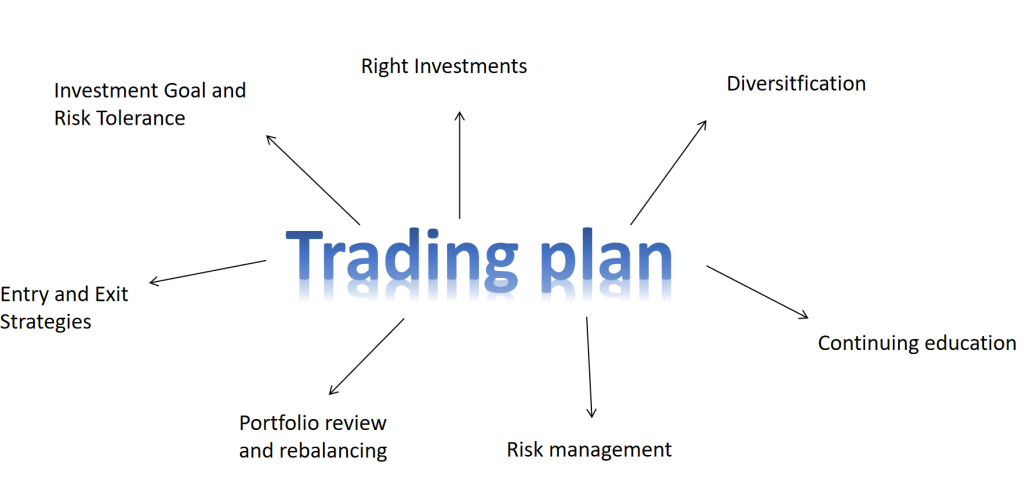
Εισαγωγή
A well-structured σχέδιο συναλλαγών is essential for successful stock and ETF investing. It serves as a blueprint that outlines your investment objectives, strategies, and risk management techniques, ensuring that you stay disciplined and make informed decisions in both rising and falling markets. This chapter will guide you through creating a comprehensive trading plan, covering everything from defining your goals to managing risks and regularly reviewing your portfolio.
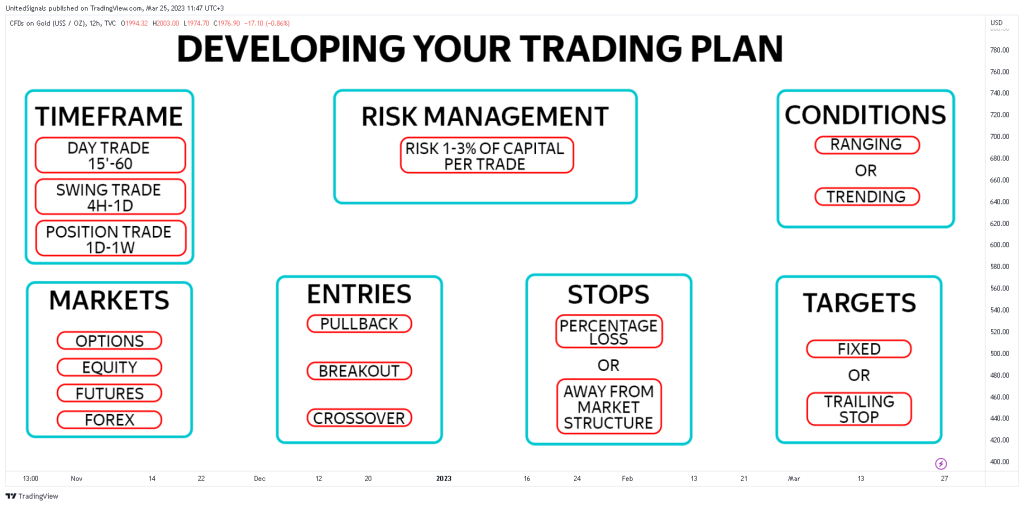
Εικόνα: Developing Your Trading Plan
Περιγραφή:
This diagram outlines the essential components of a well-structured trading plan. It includes Χρονικό πλαίσιο, defining whether the trading style is day trade, swing trade, or position trade; Διαχείριση κινδύνου, setting a 1-3% capital risk limit per trade; Conditions, which determine whether the market is ranging or trending; Markets, specifying options, equity, futures, or forex; Entries, identifying potential pullbacks, breakouts, or crossovers; Stops, including percentage loss limits or stops based on market structure; and Targets, which could be fixed or trailing stops.
Βασικά συμπεράσματα:
- Χρονικά πλαίσια help determine trading styles and align with personal availability.
- Διαχείριση κινδύνου is critical to preserve capital and manage losses.
- Συνθήκες αγοράς guide strategy adjustments (ranging vs. trending).
- Entry strategies define when to enter trades based on technical patterns.
- Stops and targets provide clear exit criteria to manage risks and lock in profits.
Εφαρμογή πληροφοριών:
This trading plan framework is useful for traders aiming to develop a clear and consistent trading strategy. By following this structured plan, traders can make informed decisions, limit potential losses, and adapt strategies based on different market conditions. The framework is suitable for all traders, from beginners to experienced investors, as it encourages disciplined trading practices.
18.1 Introduce EU-Specific Methods for Assessing Risk Tolerance
In the European Union, assessing ανοχή ρίσκου is a crucial first step in building a trading plan, especially given the traditionally conservative approach many European investors take. European regulations, such as MiFID II, play an important role in shaping the methods used to assess investor profiles, ensuring that financial products match the investor’s risk capacity and preferences. For conservative investors in Europe, risk tolerance is often centered around capital preservation, income stability, and the avoidance of high volatility.
MiFID II and Risk Profiling
Under MiFID II, European financial institutions are required to conduct comprehensive suitability assessments to determine a client’s risk tolerance. This involves evaluating the investor’s financial knowledge, experience, investment goals, and capacity to absorb potential losses. MiFID II ensures that conservative investors are not exposed to overly risky products and that their portfolios reflect their preference for stability and lower risk.
- Suitability Tests: Financial advisors conduct these tests to understand how much risk an investor is willing to take, considering factors such as time horizon, investment objectives, and financial situation.
- Appropriateness Assessments: These are designed to ensure that the products offered align with the investor’s risk tolerance. For conservative investors, this might mean recommending more secure investment vehicles like government bonds, dividend-paying stocks, or conservative ETFs.
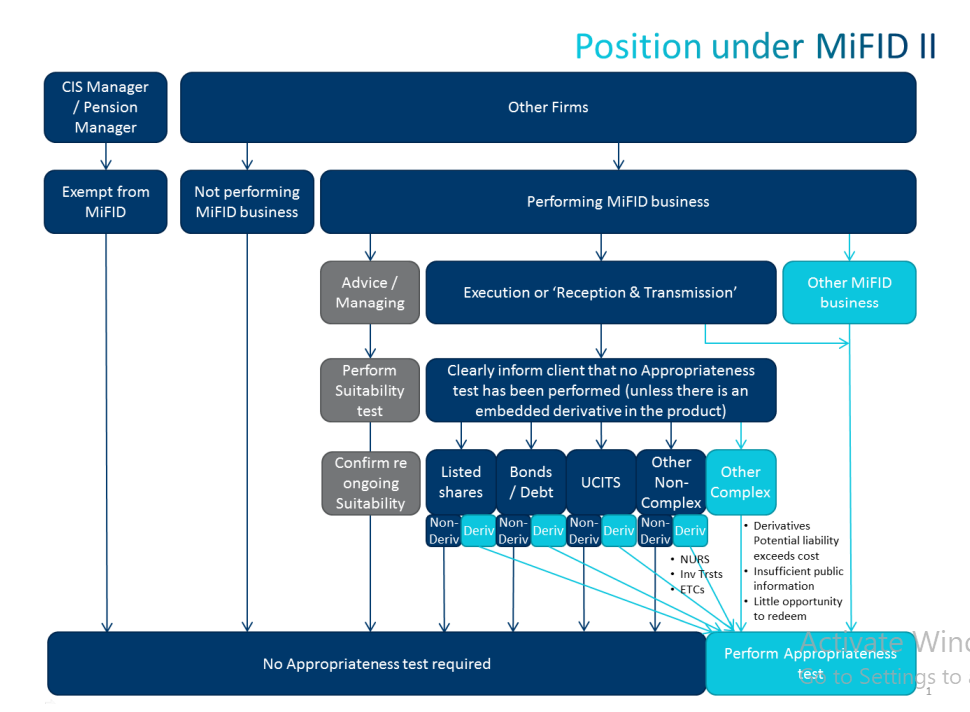
Εικόνα: Position under MiFID II
Περιγραφή:
This flowchart provides a detailed overview of how firms and clients interact under MiFID II (Markets in Financial Instruments Directive II) regulations. It differentiates firms based on whether they are performing MiFID business or not, and outlines the requirements for suitability και appropriateness tests depending on the product’s complexity. Firms offering listed shares, bonds, or UCITS without derivatives do not need to perform appropriateness tests, while more complex instruments, such as derivatives or investment trusts, require a test to ensure clients understand the risks involved. This chart helps visualize the pathway firms must follow to comply with MiFID II.
Βασικά συμπεράσματα:
- Firms are categorized into those performing MiFID business and those exempt.
- Suitability tests are mandatory for advising or managing firms.
- Appropriateness tests are required for complex instruments to ensure the client understands risks.
- Listed shares and bonds without derivatives are considered non-complex, requiring no appropriateness test.
Εφαρμογή πληροφοριών:
This flowchart is valuable for firms and compliance officers who need to navigate MiFID II regulations. Understanding when suitability και appropriateness tests are required helps firms provide clear client communication and ensures that investors are aware of the risks associated with more complex financial products. It is a critical tool for maintaining regulatory compliance in the European financial market.
Conservative European Investor Preferences
European investors, particularly in countries like Γερμανία, Ελβετία, και the Netherlands, tend to favor conservative investment strategies. These strategies focus on long-term wealth preservation, low volatility, and stable returns. Conservative investors often prioritize the following:
- Διατήρηση κεφαλαίου: Protecting the initial investment is a key priority, with a preference for less risky assets such as government bonds or blue-chip stocks that offer steady returns.
- Stable Income: Dividend-paying stocks, fixed-income products, και low-risk ETFs are popular among conservative investors. These provide a reliable income stream without the high volatility seen in growth-oriented stocks.
- Low Volatility: Many European investors seek to minimize exposure to volatile markets, preferring assets that offer steady, predictable returns. Real estate investment trusts (REITs) και utility stocks are often included in conservative portfolios for this reason.
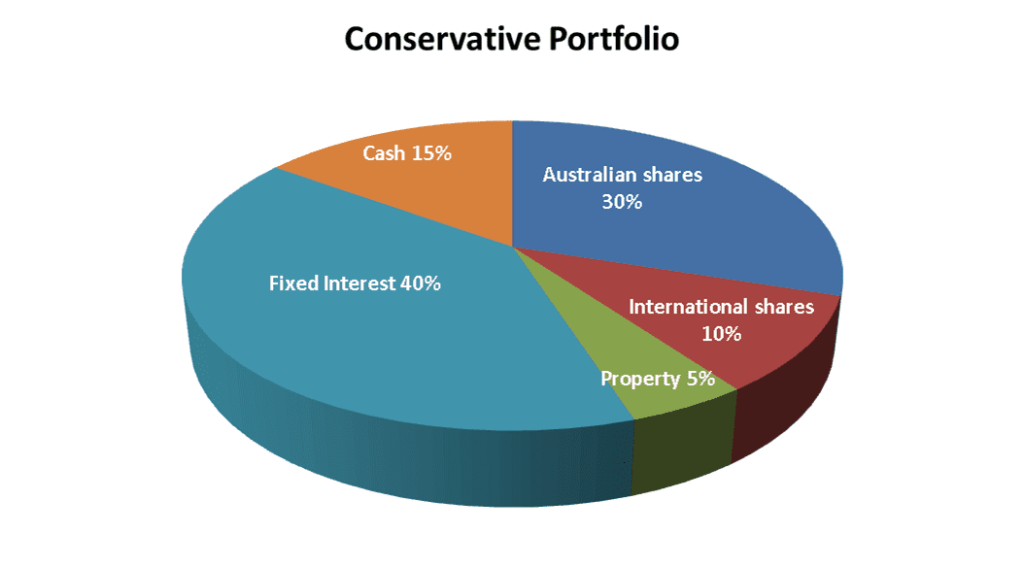
Εικόνα: Conservative Portfolio
Περιγραφή:
This pie chart illustrates the asset allocation of a conservative investment portfolio. It is primarily focused on capital preservation while generating moderate returns. The largest allocation is to fixed interest investments at 40%, followed by Australian shares at 30%. Μετρητά holdings make up 15% of the portfolio, while international shares και property are allocated 10% and 5%, respectively. This diversified approach aims to reduce risk and maintain stable returns over time, balancing between income generation and minimal exposure to more volatile assets.
Βασικά συμπεράσματα:
- Fixed interest is the largest component, representing 40% of the portfolio, aiming for stable income.
- Australian shares make up 30%, providing some exposure to equity growth.
- Μετρητά holdings at 15% ensure ρευστότητα και safety.
- International shares και property add diversification, albeit with smaller allocations (10% and 5%, respectively).
Εφαρμογή πληροφοριών:
This conservative portfolio example helps investors understand how to allocate assets when their goal is capital preservation with low to moderate growth. Investors seeking steady returns with minimal volatility may consider similar allocations. It emphasizes the importance of a diversified approach, reducing risk while still participating in equity markets and maintaining liquid assets for flexibility.
Popular Conservative Investment Options in the EU
For conservative European investors, there are several options that cater to their risk profile, ensuring low volatility and steady returns:
- Government Bonds: Bunds (German government bonds) και gilts (UK government bonds) are popular among European investors for their safety and reliability. These bonds offer modest returns but are considered safe, particularly in times of market uncertainty.
- Dividend-Paying Stocks: Established European companies like Φωλιάζω, Γιουνίλβερ, και Συνολικές Ενέργειες offer stable dividends and low volatility, making them attractive to conservative investors seeking consistent income.
- Low-Risk ETFs: Broad European market ETFs such as those tracking the Euro Stoxx 50 ή FTSE 100 provide diversification across multiple sectors, reducing risk while providing exposure to well-established companies.
- Real Estate and REITs: European real estate, particularly in stable markets like Γερμανία και Γαλλία, is a key focus for conservative investors. ΑΕΑΠ offer a way to invest in income-generating real estate without the need for direct ownership.
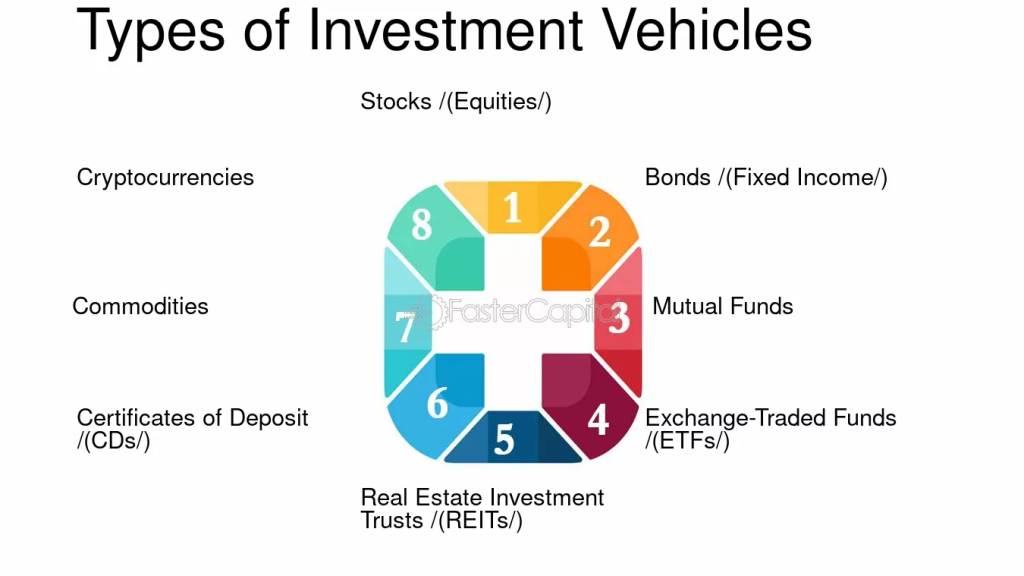
Εικόνα: Types of Investment Vehicles
Περιγραφή:
This figure presents the eight primary types of investment vehicles that investors can use to build a diversified portfolio. These vehicles range from stocks (equities), which represent ownership in companies, to bonds (fixed income), which are debt securities offering regular interest payments. Mutual funds και exchange-traded funds (ETFs) pool money from multiple investors to invest in diversified assets. Καταπιστεύματα επενδύσεων σε ακίνητα (REIT) offer exposure to real estate, while πιστοποιητικά κατάθεσης (CD) are time-bound deposit accounts with guaranteed returns. Εμπορεύματα include tangible goods like gold or oil, and κρυπτονομίσματα represent digital assets like Bitcoin and Ethereum. Each vehicle carries different risk levels, return potential, and investment characteristics.
Βασικά συμπεράσματα:
- Stocks (Equities) represent ownership in a company and offer the potential for high returns but also come with higher volatility.
- Bonds (Fixed Income) provide steady income through interest payments, typically with lower risk than equities.
- Mutual funds και ETF offer investors an opportunity to invest in a diversified collection of assets, reducing individual risk.
- ΑΕΑΠ allow investors to gain exposure to the real estate market without directly buying property.
- CDs are among the safest options, offering fixed returns over a specified term.
- Εμπορεύματα και κρυπτονομίσματα provide diversification benefits but can be highly volatile.
Εφαρμογή πληροφοριών:
Understanding these investment vehicles helps investors select suitable options based on their ανοχή ρίσκου, investment horizon, και οικονομικοί στόχοι. By using a combination of these vehicles, investors can achieve διαποικίληση, balancing potential returns με διαχείριση κινδύνου across different asset classes. This knowledge enables investors to craft a well-rounded portfolio that aligns with their objectives.
Cultural Influence on Risk Tolerance in Europe
Cultural factors also influence the risk tolerance of European investors. In Γερμανία, for example, there is a strong cultural preference for saving over investing, leading to more conservative investment strategies. Similarly, Swiss investors prioritize financial security and low-risk assets, while countries like Ισπανία και Ιταλία tend to balance conservative strategies with moderate risk.
This cultural emphasis on caution and stability means that European investors often favor secure, long-term investments over speculative or volatile assets, aligning with their conservative risk profiles.
Εικόνα: Performance of European countries on the Civil Unrest Index and number of farmer protests in 2024
Περιγραφή:
This map shows the Civil Unrest Index και farmer protests in Europe from January 1 to February 2, 2024. Το Civil Unrest Index categorizes risk levels into three groups: very high risk (0.00 – 2.50), high risk (>2.50 – 5.00), και medium risk (>5.00 – 7.50), with darker red representing higher risk. Blue circles indicate the number of farmer protests across countries. Germany has the highest number of protests (865), followed by France (628) and Italy (188), suggesting significant unrest in these regions. Conversely, some countries like Σουηδία, Νορβηγία, και Φινλανδία have relatively fewer protests, indicating lower levels of civil unrest.
Βασικά συμπεράσματα:
- Γερμανία, Γαλλία, και Ιταλία are experiencing high levels of farmer protests, correlating with high civil unrest risks.
- Southern Europe, συμπεριλαμβανομένων Ισπανία και Ελλάδα, also shows a significant number of farmer protests.
- Northern European countries have relatively fewer farmer protests, suggesting lower civil unrest in early 2024.
- ο Civil Unrest Index visually depicts regions with elevated social risks through color coding, emphasizing regions with urgent attention.
Εφαρμογή πληροφοριών:
This data can help investors and policymakers understand which countries are experiencing social and political instability, affecting potential investment risks. Knowledge of civil unrest trends aids in διαχείριση κινδύνου, guiding investment decisions in sectors sensitive to social stability, such as agriculture και ακίνητα. For those studying geopolitical risks, this map illustrates the importance of regional social dynamics in Europe.
συμπέρασμα
Assessing risk tolerance in the European market requires a deep understanding of both MiFID II regulations and the conservative preferences of many European investors. By focusing on capital preservation, stable income, and low volatility, European investors can align their portfolios with their long-term financial goals. Popular conservative investment options, including government bonds, dividend-paying stocks, and low-risk ETFs, provide stability while adhering to the risk-averse nature of many European investors. Cultural influences, coupled with regulatory frameworks, ensure that conservative investors in Europe are well-protected and positioned for steady, reliable returns.
Βασικές πληροφορίες μαθήματος:
- MiFID II regulations require financial institutions to conduct suitability assessments to determine an investor’s ανοχή ρίσκου. This ensures that the financial products recommended match the investor’s knowledge, goals, and ability to absorb losses.
- Conservative European investors typically prioritize capital preservation, stable income, και low volatility. They often favor investments like κρατικά ομόλογα, dividend-paying stocks, και low-risk ETFs that provide predictable returns without significant risk.
- Suitability and appropriateness tests under MiFID II ensure that investors are not exposed to overly risky financial products. For conservative investors, these tests often result in more secure, stable investments, such as government bonds or blue-chip stocks with strong dividends.
- Investment vehicles σαν ΑΕΑΠ, δεσμούς, και dividend stocks cater to the preferences of conservative investors by offering steady income και capital preservation. These investment options provide stability and protection from market volatility.
- Cultural factors heavily influence the ανοχή ρίσκου of European investors. For instance, in Γερμανία, there is a strong cultural focus on οικονομία rather than speculating, leading to more conservative investment strategies. In contrast, Ιταλία και Ισπανία may incorporate slightly higher risk in their investment approaches.
Τελική δήλωση:
Risk tolerance plays a critical role in building an investment portfolio, especially in the EU market. By understanding how regulations like MiFID II work alongside investor preferences and cultural factors, you can make informed decisions about the types of investments that align with your personal risk profile.

